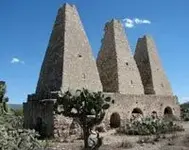Dear gollum;
I am NOT twisting anything, my friend. After all, if a statue were gilded in silver, how would one know if he were a visitor? Having read through the entire letter of Fr. Juan Nentvig, one may safely assume that the missions of New Spains were indeed financially poor. Instead of taking a specific word or sentence and placing under a microscope, I read the document in it's entirety, and these are some of pertinent points.
"Although the province of Sonora is rather large and complex with many reales de minas, towns and ranches peopled by Spaniards and gente de razón, there are only three curacies. The first is San Juan Bautista which was abandoned May 3, 1751, as stated in chapter ix, section one, and while in a physical sense its church still remains, its minister61 resides at San Miguel de Horcasitas where services are conducted in the presidio's chapel. The church edifice at San Miguel de Horcasitas was begun in 1753 by Governor Don Pablo de Arce y Arroyo during the boom days of the Antúnez gold mine. Today the edifice remains roofless and its adobe walls subjected to ruin by the rains. Because of the decadence of the Antúnez real, there is little hope the building will be completed unless a rich mine is discovered in that region soon. Its residents are extremely poor and support themselves solely by working their fertile land. But they have no outlet for their produce. They have plenty of food, but they go almost naked.
Another curacy is located at Nacozari with a well equipped church of suitable capacity, but because of the meager population of the real of Nacozari and for security reasons, its father, Curate Don Joaquín Félix Díaz, resides at the presidio of Fronteras where he has better facilities for escort when he visits the ministries under his charge. Services are conducted in the fort's chapel, newly erected in 1763.
The areas of both these curacies are so large that the two priests, having no assistants, find it extremely difficult to attend them. To visit the places of their respective jurisdictions, each priest must travel more than two hundred leagues with imminent risk of being attacked by Apaches or Seris.
The third curacy, San Francisco de Asís, is no smaller than the others, for it covers not only a part of Ostimuri Province but a good portion of Sonora as well, comprising the area from the right bank of the Yaqui River on the south and east to San Miguel de Horcasitas on the north, excluding Ures, Mátape, and Batuc. The residence of the curate, formerly in San Miguel, is now in the real of Río Chico in the province of Ostimuri. And because there are only three diocesan priests in Sonora, the Jesuit missionaries, without neglecting their own districts, help them as much as they can by imparting the faith, performing all religious functions and turning over all tithes collected to the curate. Because I am bound to tell the truth, I must say that the Jesuits ministering in this section do it all except in the place and its immediate vicinity where the curate Florencio de Alarcón, Bachelor of Theology, resides. He does visit the closer churches occasionally, but as for the more distant parishes, he merely sends someone to gather the dues accrued through the labors of others.
Regardless of the size of these curacies, when the province was booming, not beset by enemies, all its pueblos inhabited and its mines worked with zeal and very productive, even then the province was not a large source of income for the church.
Father Juan José de Grijalva, Bachelor of Theology, informed me that the curacy he had administered for thirty years, the San Juan Bautista, had an estimated annual tithe income of two to three thousand pesos a year beyond his 2,000 pesos yearly salary. Yet he was only netting 1,000 pesos a year. To live with some degree of comfort he had to pledge the tithes to purchase a ranch.
If the San Juan Bautista Curacy, supposedly the best in Sonora, was in such shape, it seems to me that the reason for its meager income was due to the charity of this venerable curate emeritus who condoned all dues to the poor, took livestock from others in payment,
and gave nearly all the revenues to his assistants in the parishes they attend. He passed away—morte justorum—in January, 1763, and was buried in Our Lady of the Rosary Chapel in the Oposura church.
The Nacozari Curacy could be as productive as the San Juan Bautista, perhaps even more so by as much as 300 pesos a year, because the Tubac presidio has been added to it. However, because the soldiers are not paid in coin but in goods at prices set by government regulations, this possible source of income is questionable.
These curacies are under the diocese of Durango. When a vacancy occurs, its bishop submits a list of three names of persons the bishop feels are competent to serve as curate in that curacy. The vicar selects one from the list whom he deems best suited for the post. However, since the curate of Nacozari, Don Joaquín Rodríguez Rey, was murdered by Apaches in 175569 despite the military escort that accompanied him, there are few diocesan priests willing to come to these regions. At present Joaquín Félix Díaz, vicar and ecclesiastic arbiter, is serving temporarily as curate. However, the curates of San Miguel de Horcasitas and Río Chico acquire their positions only after surviving competition and receive prebends which go with the post. The first was obtained by minister Miguel de Arenívar and the second by curate Florencio de Alarcón. "
I do not read of any silver banisters, opulent surroundings, vast banquets on Holy or Feast Days, or anything else that might indicate that the three Curiates in question were anything more than dirt poor communities, barely able to sustain themselves. I have taken this opportunity to highlight one passage in red, as it seems to sum up so very well the financial state of affairs in New Spain at the time. It is here that Fr. Nentvig laments over the poverty stricken region and indirectly accuses the colonists and natives of not paying their annual tithes, which most likely did not endear him to the Spaniards. As another point of fact, Fr. Nentvig was one of the seven Jesuits who perished on the forced march during their expulsion from the New World. He was the fourth Jesuit to die and studying the writings of the period in question, it would seem plausible that the Spanish colonists exacted their revenge on those Jesuits whom they had assumed were causing them the most trouble, and who could perhaps be used as eyewitnesses against them in the future.
We may pore over the contents of this document and debate it's veracity, word by word, sentence by sentence and passage by passage, and it will not alter the content or intent of the document in question, for that which has been written, has been written.
Your friend;
LAMAR



 give the picture of yourself a kiss good night when you go to bed, and if you feel like you've been slandered have your lawyer call me and we'll talk about the acid trip comments, I know how to save this stuff too.
give the picture of yourself a kiss good night when you go to bed, and if you feel like you've been slandered have your lawyer call me and we'll talk about the acid trip comments, I know how to save this stuff too. 


